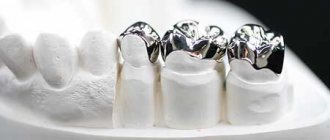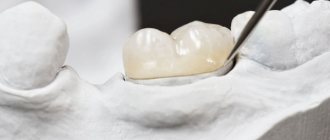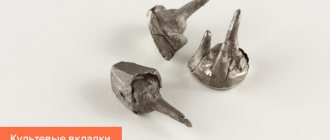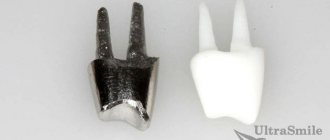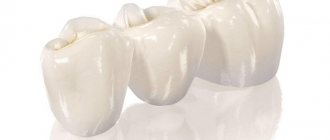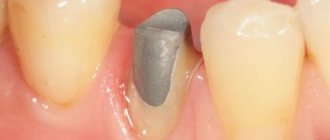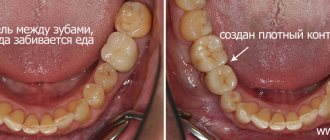A ceramic inlay is a micro-prosthesis, used when a tooth cannot be restored with a filling.
The inlays differ in the material they are made of. Main types:
- Ceramic dental inlay - classic design, the best combination of price and quality;
- Zirconium oxide, pressed ceramics, i-max - the most modern materials, maximum strength and durability;
- A composite inlay is similar to a filling, but is made in a dental laboratory due to its large volume.
Caring for your teeth after installing a ceramic inlay
After prosthetics with a ceramic inlay, the patient immediately returns to normal life. Try not to load the teeth restored with inlays for two to three days; it is better to chew food on the opposite side.
General recommendations:
- Drink coffee, strong tea and other coloring compounds in reasonable quantities.
- Do not abuse hot or too cold foods, especially alternating them. This can lead to weakened adhesion between the inlay and the tooth surface.
- Eliminate sticky and astringent foods from your diet.
- Make sure your food is not too hard.
In terms of hygiene, dentists recommend:
- Be sure to brush your teeth twice a day.
- Use a soft or medium toothbrush with ceramic inserts installed.
- Rinse your mouth after eating.
- Use special brushes to clean interdental spaces. This must be done carefully and carefully so as not to injure the gums.
If you follow the indicated recommendations, the tooth, after treatment with a ceramic inlay, will last 10 years or more.
Types of products
Experts distinguish between two main types of orthopedic structures: stump and restorative. A ceramic core inlay is required to restore the tooth core for subsequent fixation of the crown. Most often it is used for prosthetics of incisors. Restorative structures are used for chewing teeth when one or two surfaces are damaged. In addition to high aesthetics, they are characterized by reliability and durability. Also, the tabs are distinguished by the material used. Below are the most common materials from which products are made.
- pressed ceramics. Products are produced using porcelain injection molding. The procedure is carried out under conditions of high temperature and pressure. Compared to orthopedic structures made of metal or zirconium dioxide, they are not as durable, but are ideal from an aesthetic point of view;
- zirconium dioxide. They are made by grinding finished metal oxide blanks. Grinding is carried out automatically using a ready-made impression (plaster model) of a damaged molar or premolar. Thanks to computer control, finished structures are characterized by high quality. Upon completion, the workpiece is fired, fusing the porcelain mass. Zirconium dioxide is a high-tech material for orthopedic structures, and therefore is in special demand. From an aesthetic point of view, such inlays are in no way inferior to porcelain products, and in terms of strength they are not inferior to metal products;
- metal. The metal most often used is gold or a silver-palladium alloy. Such designs are reliable, but do not have high aesthetics;
- metal ceramics. This is the latest orthopedic design, which is distinguished by high aesthetics, but at the same time cannot boast of proper quality. Due to thermal exposure, such products often fall out of the mouth. Most experts advise installing a structure made of zirconium dioxide or pressed ceramics rather than metal ceramics.
When salvation is a crown
A dental inlay is a way to save a tooth when it is not possible to fill it. If the damage is significant, then a filling or inlay will not help; more reliable protection will be required - a crown
.
Modern designs are durable and help maintain quality of life when 50% or more
of tooth tissue is lost.
Restoring a tooth with a crown (the price is calculated depending on the chosen material) is reliable protection against recurrent caries. Microparticles of food do not get under the crown, pathogenic microflora do not penetrate, and there is no violation of the marginal seal.
Ceramic, metal-ceramic or zirconium crowns on a tooth will become a reliable covering for the thinned, fragile walls of a natural tooth and will protect them from chipping or breaking.
Modern dentistry makes it possible to bring the shade of the crown as close as possible to the natural shade of the enamel, so the presence of the structure is almost invisible. Installing crowns on chewing teeth is an opportunity not to limit your diet, to eat familiar foods without fear of destruction of the teeth.
Indications and contraindications for installation
Indications for tooth restoration using a ceramic microprosthesis:
- The need to restore chewing teeth that have a significant cavity formed as a result of caries or trauma, when it is impossible to eliminate the defect with filling. The technique is perfect even in cases where it is necessary to restore up to 50% of damaged tooth tissue.
- We are talking about replacing old large fillings. The need for tissue preparation, which involves the refilling procedure, will further enlarge the existing cavity and thin the walls of the tooth. Under such conditions, installing a new seal will not ensure reliability.
- There is a pathological abrasion of tooth tissues and, as a consequence, their destruction. Ceramics, which have increased strength, can completely prevent the loss of hard tissues due to their abrasion.
- Cases where the destruction of the coronal part of the tooth is great, it is possible to avoid depulping and covering the tooth with a crown.
You will have to refuse to use a ceramic inlay in the following cases:
- More than half of the destroyed tooth tissue needs to be restored. In this case, the only possible solution to save the tooth and avoid its removal is filling and subsequent installation of a crown.
- We are talking about baby teeth or numbers of eights. With such extensive damage to the wisdom tooth, surgical tactics are taken as the basis; removal will be required.
The main differences between a filling and a ceramic inlay
A ceramic inlay differs from a filling in a number of ways:
- The material from which ceramic inlays are made is similar in physical and chemical properties to natural tooth tissue, due to which microprostheses are significantly superior to any type of filling in terms of strength and resistance to abrasion.
- Regarding aesthetics, the ceramic inlay looks completely identical to the tooth tissues, matching them in color and transparency. At the same time, the filling may have a different shade.
- The inlay is used to restore chewing teeth with significant tissue defects. The filling is used for small, no more than 30%, affected areas, which is associated with insufficient hardness of the material. If you try to install a larger filling, it will not be possible to ensure a sufficient quality of its fit, which will lead to the risk of reoccurrence of caries. At the same time, if all preparatory measures were carried out correctly, a ceramic onlay will reliably avoid such complications.
- In terms of service life, ceramic inlays have clear advantages. If a filling guarantees preservation of the result for about 5 years, then with the help of a microprosthesis you can expect that the tooth will last over 10 years.
- If a filling is made directly in the patient’s mouth by a dental therapist, then ceramic microprostheses are created in the laboratory, and the entire process is controlled by an orthopedic dentist. The course of treatment takes longer, but thanks to the technological features of the technique, the specialist has the opportunity to install a microprosthesis more tightly than a filling.
- The method of restoring a tooth using a ceramic inlay is more expensive. However, this conclusion is not absolute, since in the long term the patient receives a more reliable and durable restoration result.
Types of tabs
Today, the most popular classification of ceramic inlays, developed by the American Dental Association ADA, is considered. According to it, the following types of tabs are distinguished:
Inlay – a microprosthesis is fixed inside the tooth. In this case, restoration of the tubercles is not expected; the tab is, as it were, sandwiched between them. Such features ensure its high functional performance and viability. However, these clinical prerequisites make it possible to use a filling quite successfully, so specialists take an extremely balanced approach to choosing an inlay.
Onlay - this option of an inlay is used if one or more cusps of the tooth are destroyed and need restoration. By using an inlay, some of the cusps on the tooth remain their own, and some are replaced with a ceramic microprosthesis. However, when carrying out a chewing load, an overturning moment may occur, which negatively affects the fixation of the structure. Only a specialist’s impeccable knowledge of the anatomy of the dentofacial system, thorough diagnostics and impeccable precision in the execution of work can ensure the required quality of restoration carried out using this method.
Overlay is an option in which the inlay covers all the cusps of the tooth, which ensures maximum fastening strength. In such a clinical case, the doctor will be faced with a dilemma whether to use an inlay or perform additional grinding of the tooth and install a crown.
Pinlay is a special version of the inlay, which involves the presence of a pin in its design, with the help of which better fixation of the entire structure is ensured. This option is suitable for any type of inlay, on any tooth.
How a ceramic inlay is created for teeth
The production of a ceramic inlay goes through several stages:
- If necessary, the doctor removes the remains of old fillings, damaged tooth tissue, smoothes the walls of the cavity, which will ensure high-quality impressions and, in the future, a tight fit of the inlay. Then the resulting cavity is treated with medication.
- Taking an impression. Since the inlay is a microprosthesis, it is to the dental laboratory that the finished impressions are sent.
- The laboratory stage assumes that, based on the impressions obtained, the dental technician casts a plaster model, and then restores the lost part of the tooth using ceramic mass. The process consists of applying the material in thin layers and sequential firing in a special oven, where, in addition to high temperature, about 700 degrees, vacuum conditions are created. The color of the ceramic microprosthesis is selected individually, taking into account the basic tone of the patient’s enamel. The created product is carefully polished and handed over to the doctor. The use of ultra-precise technology and computer modeling techniques allows us to take this technology to a new level, significantly increasing the quality of the resulting product and the compliance of the microprosthesis with the cavity being restored. When creating an e.max Press ceramic inlay, standard impressions are not required. The doctor will receive the necessary information by scanning the tooth, nearby and opposite areas using a compact 3D camera. The software will be used at each subsequent stage, when creating a virtual model of a tooth, an inlay, as well as when turning a real model on a special milling module connected to a computer. By making an inlay using this method, using computer technology, the impeccability of the result will be guaranteed.
- At the patient’s subsequent visit, the doctor tries on the finished microprosthesis. The specialist evaluates the fit of the tab and the contact with neighboring teeth. If no modification is required, attach it to the tooth using adhesive material.
Considering this entire multi-stage technological process, it becomes clear that such a complex design cannot be used inexpensively. In addition to direct manufacturing and payment for the services of a dental technician, the cost of diagnostics, tooth processing, taking impressions, selection of shape and color, and the purchase of expensive materials and ceramic mass are also involved in determining the price. Will increase the final cost and use of digital technologies.
Advantages and disadvantages of products
Ceramic inlays are significantly superior in quality to composite fillings. And this is due, on the one hand, to the physical and chemical properties of the material, and on the other hand, to the peculiarities of creating microprostheses. Based on these features, the advantages of ceramic inlays are:
- High manufacturing precision, which minimizes the risk of developing recurrent caries, guarantees the reliability of restorations and extends the life of the tooth. In fact, the inlay and the tooth become one. As a result of life activity, your own enamel is more likely to be destroyed than a ceramic inlay.
- Excellent aesthetic characteristics. Inlays are exactly identical to natural tooth tissue in appearance.
- High wear resistance. Ceramics are not subject to staining with food dyes and exposure to aggressive substances in the oral cavity.
- Lack of special care. It is enough not to ignore daily standard hygiene procedures and visit the dentist in a timely manner for a preventive examination and professional teeth cleaning.
Where is the best place to install ceramic inlays?
Considering the high costs of installing a ceramic inlay, the question of where it is best to carry it out is not idle. To fully obtain an aesthetic, reliable and long-term result, you need to use the services of the most qualified specialists who have extensive practical experience in installing such orthopedic structures. The specialists of the Dental Studio clinic in Moscow are the best solution.
Our dentists constantly, every day, prove their professionalism with the high-quality results of their work. Success is fully guaranteed when installing ceramic inlays. Using this technique, you can extend the life of a decayed tooth without installing a crown.
Establishment technology
High-quality production of modern inserts requires a detailed study of the casts made. The specialist enters all the necessary information into the computer program. It displays pictures and diagrams of the future design. With the help of an electronic program, even minor defects and deviations are eliminated, a shade is selected that is more consistent with the natural healthy units of a particular patient.
Installation of orthodontic ceramic products is possible only on the root organ. Of course, before installing the structure, you need to take into account contraindications. The products are not used for baby teeth, since their service life is short, unlike a ceramic device. Also, the system is placed only on a solid foundation. If the destruction exceeds 60%, the optimal prosthesis option is a crown. After all, in order to fully install the tabs, you definitely need two walls. If caries is present, therapy is first carried out. Treatment of caries in St. Petersburg is carried out in almost every clinic. Choose among them the one that meets modern requirements.
More examples
Example 1:
Here the tooth is cracked due to a large filling.
Example 2: filling with usual indications
Given:
Correct fillings:
Advantages
- They strengthen the tooth, as they have high strength;
- High aesthetics. Reliably recreates the appearance of the tooth;
- Exact reproduction of the shape of the restored unit;
- Hygiene. As a final treatment, glaze is applied to the ceramic filling, creating a glossy, smooth surface on which harmful microorganisms do not accumulate. The occurrence of plaque, which causes inflammatory processes, is excluded;
- They are resistant to mechanical and temperature influences;
- Ceramic fillings are bioinert and do not emit or absorb chemicals.
